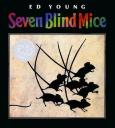Students learning about their five senses for the first time will love Seven Blind Mice, written and illustrated by Ed Young. This colorful picture book employs a simple storyline to show readers how important our senses are to our everyday lives.
The story begins when seven blind mice are surprised to find a new object by their home. One by one, the mice use their other senses in an attempt to identify this new object, and each mouse becomes convinced that he has solved the mystery correctly. “One day,” Young writes, “seven blind mice were surprised to find a strange Something by their pond. ‘What is it?’ they cried, and they all ran home. On Monday, Red Mouse went first to find out. ‘It’s a pillar,’ he said. No one believed him.” The text continues in a similar fashion until each mouse has guessed what this new Something is. Only readers are able to tell why the mice have different opinions, but the wonderful illustrations do a great job of camoflauging the actual object (an elephant!) until the end of the story.
Curriculum Connections
Seven Blind Mice is a great book for initiating discussion about the five senses in a kindergarten classroom. Children must stop and think about how being blind would affect their perception and must also consider the lesson on the last page of the book: “Knowing in part may make a fine tale, but wisdom comes from seeing the whole.” The mice learn that perception is dependent on many things, and students should think about how each of their senses allows them to learn different things about the world around them. The book might be used to satisfy SOL K.2 by encouraging students to think about how using their senses can help them to identify objects in their environment.
Additional Resources
- This site has a ton of great resources for lesson planning about the five senses!
- To find activities dealing with each of the senses, including scavenger hunts, book ideas, and poems to read aloud, check out this kindergarten teacher’s website!
- For Ten Terrific Ways to Teach the Five Senses, be sure to check out this Education World website!
Book: Seven Blind Mice
Author: Ed Young
Illustrator: Ed Young
Publisher: Putnam Juvenile
Publication Date: June 2002
Pages: 40
Grade Range: K-3
ISBN: 0698118952

